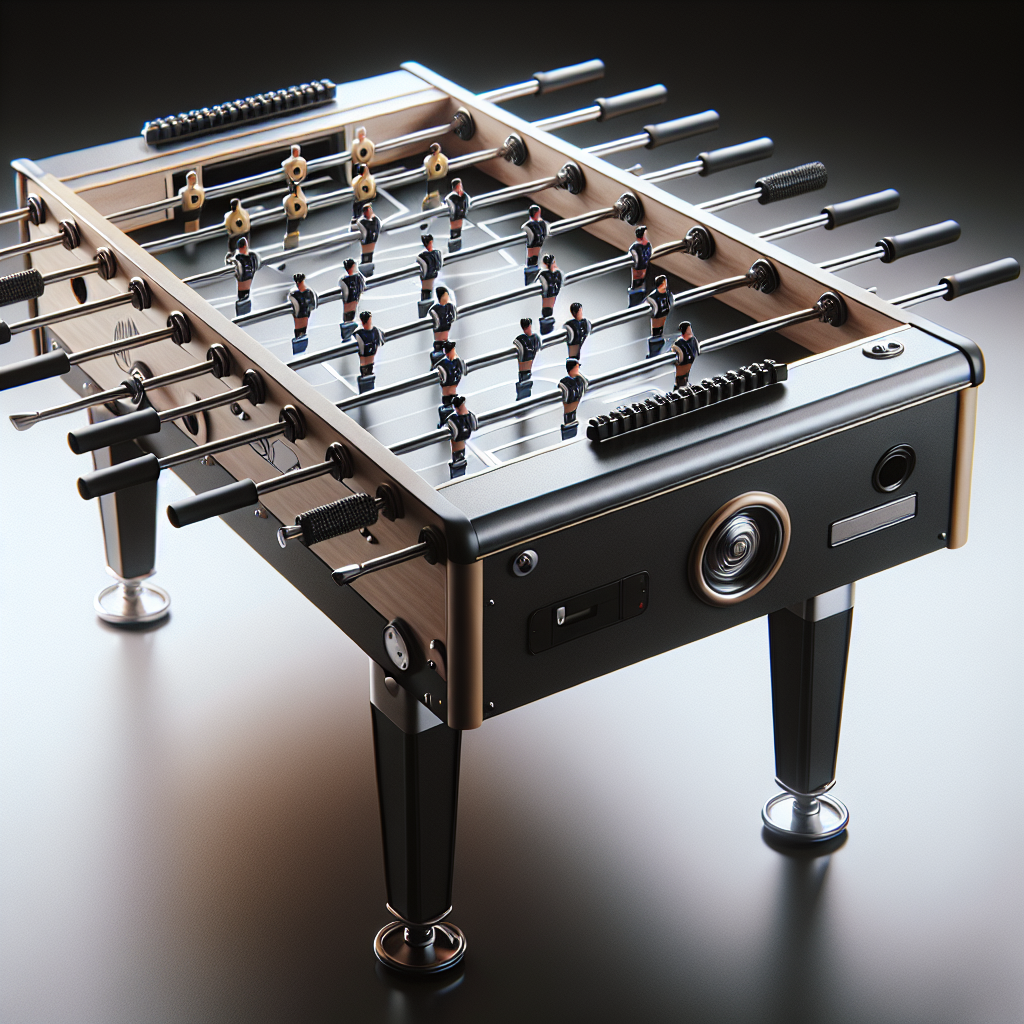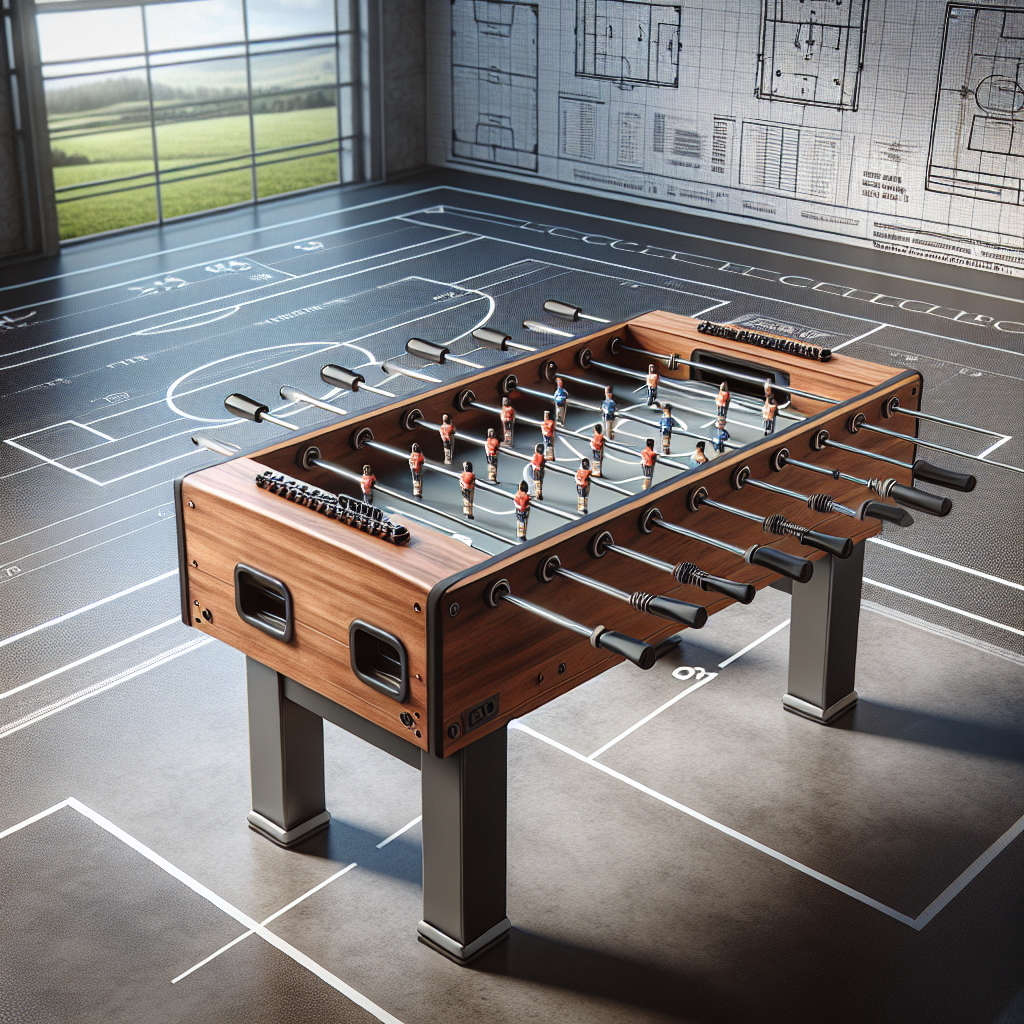Getting to Know Foosball Tables
Alright, let’s talk foosball tables. If you want to get the hang of these bad boys, you need to know about the official setups and the different ways the rods can be arranged.
Official Table Setups
Foosball tables come in different flavors, depending on who’s running the show. One big difference is the number of goalies. Some tables have three goalies, while others stick with just one. The three-goalie setup was introduced to keep the ball from flying off the table, which used to be a real headache with those corner ramps (Foosball.com).
Rod Setup Variations
Now, let’s talk rods. The number of players on each rod can change from table to table. Some tables have two players on the goalie rod and three on the defense rod. Others flip it around with three on the goalie rod and two on defense. There’s no hard and fast rule here, so you get a bit of freedom to mix things up (Foosball.com).
Knowing these setups and variations is a game-changer for both players and fans. It helps you roll with different table styles and makes your foosball experience way more fun. Want to know more about the best foosball tables out there? Check out our guide on the best foosball tables.
Picking the Perfect Foosball Table
Choosing a foosball table isn’t rocket science, but there are a few things you should know to get the best bang for your buck. Let’s break it down: size and dimensions, types of tables, and what to keep in mind when buying one.
Size and Dimensions
Foosball tables come in all shapes and sizes. The official competition-size table is usually 56 inches long, 30 inches wide, and 36 inches tall. But hey, not everyone has a game room the size of a football field. Measure your space and pick a table that fits. If you’re tight on space, mini foosball tables might be your jam. They range from tabletop versions to small freestanding ones. Check out our guide on foosball table dimensions for more details.
Types of Foosball Tables
Foosball tables come in three main flavors:
-
Stand-alone Tables: These are the big boys. They need their own space but offer a solid, authentic playing experience. You can find them in different styles, like cabinet-style or even outdoor versions. Curious about outdoor tables? We’ve got you covered with our article on outdoor foosball tables.
-
Tabletop Tables: Perfect for those who want to play but don’t have a ton of space. Just plop them on any flat surface and you’re good to go. They’re usually cheaper and great for casual play or kids. Want more info? Check out our piece on mini foosball tables.
-
Multi-game Tables: These are the Swiss Army knives of game tables. They offer multiple games like air hockey, ping pong, and of course, foosball. Great for families who want variety without needing a separate table for each game.
What to Consider When Buying
Here are a few things to keep in mind:
-
Quality and Durability: Look for sturdy construction and durable materials. Pay attention to the rods, player figurines, play surface, and cabinet. A good table often comes with a warranty, so check that out too.
-
Price Range: Foosball tables can be cheap or they can cost an arm and a leg. Decide on your budget and find a table that offers good value. Remember, pricier tables usually mean better build quality and extra features.
-
Replacement Parts: Eventually, parts will wear out. Make sure you can easily get replacement parts for the table you choose. This will help keep your table in good shape for years to come.
For a rundown on the best foosball tables out there, take a look at our article on the best foosball table. By keeping these tips in mind, you’ll be well on your way to finding the perfect foosball table for endless fun.
Building a Foosball Table
Got a knack for DIY and love a good challenge? Building your own foosball table might just be your next big project. Let’s break down the process, the materials you’ll need, and why customizing your table is a game-changer.
DIY Foosball Table Construction
Creating a foosball table from scratch isn’t just about slapping some wood together. It takes planning, precision, and a bit of elbow grease. Take a leaf out of the book of a DIY enthusiast who replicated the Cyclone II foosball table from Tornado for a fraction of the cost. The step-by-step guide on Foosball.com shows how they did it with solid wood and a lot of patience.
Here’s the gist: cut pieces from birch plywood, assemble and paint the legs, apply the playfield image using multiple sheets of paper, cut notches in the plexiglass, and put together the cabinet in two halves. Sounds like a lot? It is, but the payoff is worth it.
Materials and Cost
Choosing the right materials is key. To match the sturdiness of a professional table like Tornado, use 3/4″ plywood, doubled up in some parts, along with wood glue and screws. This ensures your table can handle even the most intense foosball matches without wobbling.
According to Foosball.com, the total cost for this DIY project was $261.08. Compare that to the price of a high-quality store-bought table, and you’re looking at some serious savings.
Benefits of Customization
The best part about building your own foosball table? Customization. You get to pick the materials, finishes, layout, and design. Want a neon green playfield? Go for it. Prefer a sleek, modern look? You got it. You can even add unique features or personal touches that reflect your style.
Plus, there’s nothing quite like the sense of accomplishment from completing a DIY project. Your custom foosball table isn’t just a game; it’s a testament to your craftsmanship and creativity. It’s a conversation starter and a source of pride every time friends or family come over to play.
Building your own foosball table means saving money and creating something that fits your exact needs and preferences. If you’ve got the time, skills, and enthusiasm, this project can be incredibly rewarding.
Not into DIY? No worries. Check out our guide on the best foosball table to find the perfect ready-made option. Whether you build or buy, the fun of foosball is just a table away.
Features of Professional Foosball Tables
So, you’re thinking about getting serious with foosball, huh? Well, let’s break down what makes a professional foosball table worth every penny. We’re talking about the playing field, the little guys (or gals) doing the kicking, and the rods that make it all happen.
Playing Field Design
The playing field is where the magic happens. Different countries have their own spin on it, and each style brings something unique to the table.
- Italian Tables: These bad boys often come with a glass playfield and are built like tanks using solid hardwood, stainless steel, and tempered glass. They meet international tournament standards, so if you’re aiming to go pro, this is your jam.
- French Tables: Think rubbery playfield and a compact design. These tables are all about ball control and skill. They usually have a single-goalie setup, making the game a bit more challenging and fun.
- American Tables: Known for their plastic laminated playfields and wide-foot figurines, these tables are all about passing the ball. They have ramped corners to keep the ball moving and rubber bumpers for better grip.
- German Tables: These are a mix of American and European styles. They feature lighter figurines for better pinning and are known for their solid construction and smooth gameplay. Telescopic rods and counterbalanced players are standard here.
- Spanish Tables: These tables have a unique “U” shaped slope towards the middle and metal players separated by two feet. They offer a challenging gameplay experience that’s quite different from the others.
Player Figurine Styles
The little dudes on the table aren’t just for show. Their design can make a big difference in how you play. Some tables have heavier aluminum figurines, while others go for lighter ones that are easier to control. Pick the style that suits your game.
Rod Options and Material Preferences
The rods are your connection to the game. Solid steel rods are tough and durable, while telescopic rods have a safety feature that keeps them from sticking out the other side, reducing the risk of injury. You can also choose between stainless steel and chrome-plated rods. Stainless steel is rust-resistant, while chrome-plated rods offer a smoother surface for better gameplay.
Making the Right Choice
Understanding these features will help you pick the perfect foosball table. Whether you’re a casual player or aiming for the big leagues, knowing what to look for can make all the difference. For more tips on choosing the best foosball table, check out our article on the best foosball table options available.








